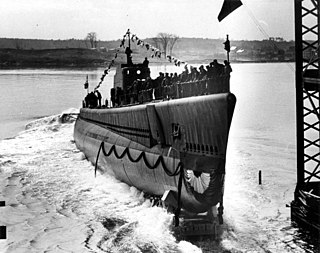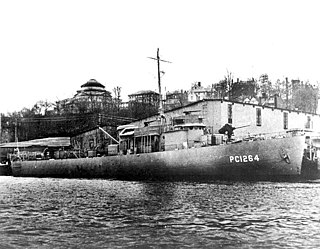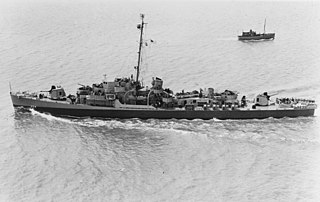
USS Big Horn (AO-45/IX-207) was a Q-ship of the United States Navy named for the Bighorn River of Wyoming and Montana.

USS Underhill (DE-682) was a Buckley-class destroyer escort of the United States Navy during World War II. Built in 1943, she served in the Atlantic, the Mediterranean, and the Pacific until her sinking in a suicide attack by a Japanese Kaiten manned torpedo on 24 July 1945.

USS Finback (SS-230), a Gato-class submarine, was the first ship of the United States Navy to be named for the finback. Nine of Finback's twelve World War II patrols in the Pacific were designated as "successful"; she received 13 battle stars for her service and is credited with having sunk nearly 70 thousand tons of enemy shipping.

USS Kingfish (SS-234), a Gato-class submarine, was the first ship of the United States Navy to be named for the kingfish.

USS PC-1264 was a PC-461-class submarine chaser built for the United States Navy during World War II. She was one of only two U.S. Navy ships to have a predominantly African-American enlisted complement during the war, the other being the Evarts-class destroyer escortUSS Mason.

USS Rudderow (DE-224) was the lead ship of her class of destroyer escorts, in service with the United States Navy from 1944 to 1947. After spending decades in reserve, she was sold for scrap in 1970.

USS Gilmer (DD-233/APD-11) was a Clemson-class destroyer in the United States Navy during World War II. She was the first ship named for Secretary of the Navy Thomas Walker Gilmer.
USS PC-1119 was a PC-461-class submarine chaser built for the United States Navy during World War II. She was later renamed Greencastle (PC-1119), after Greencastle, Indiana and Greencastle, Pennsylvania, but never saw active service under that name.
USS PC-1136 was a PC-461-class submarine chaser built for the United States Navy during World War II. Shortly after the end of the war, she was renamed USS PCC-1136 when she was reclassified as a combat communications control ship. In 1956, she was renamed Galena (PC-1136), becoming the third U.S. Navy vessel so named, but never saw active service under that name.
USS PC-1138 was a PC-461-class submarine chaser built for the United States Navy during World War II. She was later renamed Lapeer (PC-1138) but never saw active service under that name.
USS PC-1141 was a PC-461-class submarine chaser built for the United States Navy during World War II. She was renamed USS Pierre (PC-1141) in 1956, was decommissioned from the U.S. Navy in October 1958, and transferred to the Indonesian Navy as KRI Tjakalang.

German submarine U-521 was a Type IXC U-boat of Nazi Germany's Kriegsmarine during World War II.

USS Sentinel (AM-113) was an Auk-class minesweeper built for the United States Navy during World War II; she was the third U.S. Naval vessel to bear the name. It was laid down on 28 November 1941 by the American Ship Building Company, Cleveland, Ohio; launched on 23 May 1942; and commissioned on 3 November 1942.
USS Adroit (AM-82/PC-1586) was an Adroit-class minesweeper acquired by the United States Navy for the task of removing mines that had been placed in the water to prevent the safe passage of ships.

USS Direct (AM-90) was an Adroit-class minesweeper of the United States Navy. It was laid down on 26 December 1941 by the Dravo Corporation, Neville Island, Pittsburgh, Pennsylvania, launched on 25 April 1942, and commissioned on 31 August 1942. The ship started conversion to a submarine chaser on 16 May 1944 at Norfolk, Virginia, and was reclassified PC-1594 on 1 June 1944.
USS Engage (AM-93) was an Adroit-class minesweeper of the United States Navy. Laid down on 26 February 1942 by the Dravo Corporation, Neville Island, Pittsburgh, Pennsylvania, launched on 11 July 1942, and commissioned on 22 October 1942. The ship was reclassified as a submarine chaser, PC-1597 on 1 June 1944.

USS Natchez (PG-102/PF-2) was a River-class frigate acquired by the U.S. Navy during World War II. She was originally ordered and laid down as HMS Annan for the Royal Navy, and renamed as HMCS Annan for the Royal Canadian Navy before transfer to the U.S. Navy before launch. She was used for anti-submarine patrol work during the war.
USS Cymophane (PYc-26) was a Cymophane-class patrol yacht acquired by the United States Navy early during World War II. She was used for patrol, escort, anti-submarine, and rescue operations along coastal waters.

USS Keith (DE-241) was an Edsall-class destroyer escort in service with the United States Navy from 1943 to 1946. She was scrapped in 1974.
USS PC-1230 was a Patrol Craft, laid down in 1942, participating in escort and convoy missions in the Pacific in World War II, and performed harbor control duties during the Battle of Peleliu.











